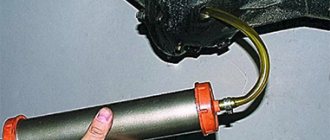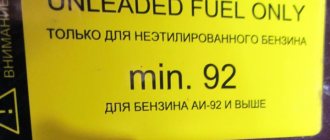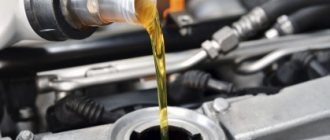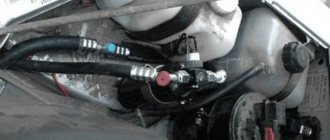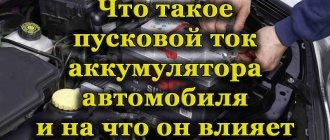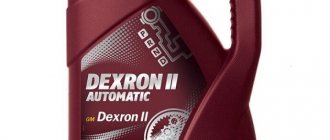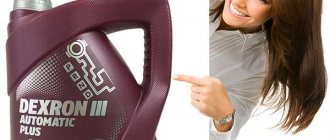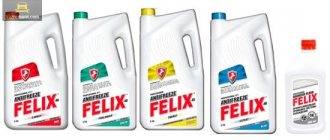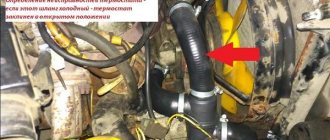01/19/2022 27 177 ECU
Author: Ivan Baranov
Hydraulic power steering is designed to make steering easier, as well as dampen vibrations and shocks that occur on the steering wheel. In order for it to last a long time and work stably, it is necessary to regularly change the oil in it and monitor its quality. The article discusses Dextron oils, including Dextron 3 for power steering, and gives their description, advantages and disadvantages.
[Hide]
What is Dexron and what is it for?
Dextron is a service transmission fluid for automobiles developed by General Motors in 1968.
The development became an innovation and people began to take its excellent name without giving anything in return, and soon the name was accepted as a kind of standard for transmission oils, i.e. class 3, 4, 5 to which the fluid must comply for use in certain transmissions.
The most popular liquid currently is Dexron 3, which appeared on the market back in 1993. This automatic transmission fluid is very popular due to its price and availability. For used cars, this is an excellent option that you can safely pour into an automatic transmission and be confident in the future, but you need to pour the best, and the best is not always the most expensive, which is why take a look at the test results in the table.
An automatic transmission is a much more complex mechanism than a mechanical one; an automatic transmission has gears, but a manual transmission does not. Also, in an automatic transmission, lubrication of the friction chains is almost the most important thing, and it is the oil that transmits torque in the torque converter.
At the end of the article you will find a useful video!
Types and types of Dexron liquids
Let's start with the fact that today you can find fluids ranging from Dexron 2, Dexron IID or Dexron 3 to Dexron 6. In fact, each type is a separate generation of transmission fluid, widely known as Dexron. The development belongs to the concern General Motors (GM), which in 1968 created its own transmission fluid for automatic transmissions, Dexron.
Let us note that in those years the auto industry was at a stage of active development, large automakers everywhere developed tolerances and standards for oils and transmission fluids. Subsequently, these tolerances and specifications became a mandatory requirement for third-party companies producing technical fluids for cars.
- Let's return to Dextron. After the first generation of such fluids entered the market, just 4 years later GM was forced to develop the second generation of Dextron.
The reason is that the first generation actively used whale oil as a friction modifier, and the transmission oil itself on this basis quickly became unusable due to high heat in the automatic transmission. A new formula was supposed to solve the problems, which became the basis of Dexron IIC.
In fact, whale oil was replaced with jojoba oil as a friction modifier, and the product's heat resistance was also improved. However, with all the advantages, the composition had one serious drawback - severe corrosion of automatic transmission elements.
For this reason, corrosion inhibitors began to be added to the transmission fluid to avoid the active appearance of rust. The result of such improvements was the appearance in 1975 of the Dexron IID product. Further, during operation, it turned out that the transmission fluid, due to the addition of an anti-corrosion package, tends to accumulate moisture (hygroscopicity), which led to a rapid loss of properties.
For this reason, they quickly stopped using Dexron IID, releasing the product Dexron IIE, filled with active additives that work against moisture and corrosion. It is noteworthy that this generation of liquid has become semi-synthetic.
Moreover, having convinced itself of its effectiveness, after a short period of time the concern released a fundamentally new liquid with improved performance characteristics. First of all, while earlier generations were mineral or semi-synthetic based, the new Dexron 3 ATF was made from a synthetic base.
This solution turned out to be resistant to high heat, had excellent lubricating and protective properties, and remained fluid at low temperatures (up to -30 degrees Celsius). It was the third generation that became truly universal and began to be widely used in automatic transmissions, power steering, etc.
- Today, the latest generation is Dexron VI (Dextron 6), developed for the six-speed Hydra-Matic 6L80 automatic transmission. The product has improved lubricating properties, reduced kinematic viscosity, resistance to foaming and corrosion.
Moreover, the manufacturer positions such a liquid as a composition that does not require replacement. In other words, such oil is poured into the automatic transmission for the entire service life of the unit.
Of course, in reality, the oil in the box needs to be changed every 50-60 thousand kilometers, but it is obvious that the properties of Dextron 6 are noticeably improved. As practice shows, Dextron VI also loses its properties over time, but it needs to be changed less often than the outdated Dextron III.
- Please note that different manufacturers began to produce automatic transmission fluids quite a long time ago, and the products are produced under the Dexron brand. As for GM, the concern has been producing only this type of fluid since 2006, while other oil manufacturers continue to produce Dextron IID, IIE, III, etc.
As for GM, the corporation is not responsible in any way for the quality and properties of fluids of previous generations, although they continue to be produced according to the Dexron standard. It can also be noted that today Dexron fluids can be standard or HP (high performance) for automatic transmissions that operate in difficult conditions.
There are also Dexron Gear Oils for differentials and clutches, Dexron Manual Transmission Fluid for manual transmissions, Dexron Dual Clutch Transmission Fluid for dual-clutch robotic gearboxes, Dextron for power steering, as well as other units and mechanisms. There is information that General Motors is testing the latest generation of fluid for use as a transmission oil for CVTs.
Dexron Test Results Table
| Liquid brand | Bully index | Foaming | Kinematic viscosity | Flash point | Corrosion in points | Impurity content in % | Ash content in % |
| Specification Requirements | Not standardized (bigger is better) | No more than 100 | At least 6.8 | Not less than 170 | Not higher than 1 | Not standardized (less is better) | Not standardized (less is better) |
| ZIC Dexron 3 | 390 | 10 | 8.40 | 210 | 1b | 0.0 | 0.054 |
| ENEOS ATF 3 | 401 | 20 | 7.67 | 198 | 1b | 0.009 | 0.083 |
| Bizol ATF 3 | 323 | footprints - | 8,28 | 190 | 1b | 0.012 | 0.093 |
| Mobil ATF D/M | 308 | footprints - | 7,32 | 170 | 1b | 0.007 | 0.180 |
| BP Autran DX 3 | 306 | 20 | 7.8 | 178 | 1c | 0.014 | 0.075 |
| Luxoil ATF Dexron 3 | 366 | 250 | 8.68 | 180 | 1a | 0.014 | 0.910 |
| XADO ATF 3 | 395 | footprints - | 7,28 | 195 | 2c | 0.010 | 0.120 |
| Castrol TQ Dexron 3 | 376 | 5 | 7.7 | 202 | 2a | 0.006 | 0.104 |
| Mannol Dexron 3 | 369 | 10 | 8.21 | 198 | 2c | 0.008 | 0.190 |
| Elf Elfmatic G3 | 309 | footprints - | 7.18 | 196 | 2c | 0.014 | 0.190 |
| hi gear | 304 | footprints - | 7.01 | 198 | 2c | 0.014 | 0.190 |
Dexron 2 and Dexron 3
The automatic transmission uses DEXRON-2 oil. On ancient cars 95 and older, DEXRON-II D was used, it is mineral-based; on more recent cars, DEXRON-2 E or DEXRON-III is used. In Toyotas, you can read on the oil dipstick what is pouring into the box. In any case, you should not mix mineral- and synthetic-based liquids. In Japanese cars, it is enough to know which dexton is suitable for your machine and you can safely pour it, but some owners of old cars face difficulties in finding DEXTRON2D\2E. In a car with DEXTRON2D written on the dipstick, ONLY DEXTRON2D can be poured, while on machines using DEXTRON2E can be replaced with DEXTRON3 (but not back, if the automatic transmission requires D3, it cannot be replaced with D2E). All negative opinions about such a replacement are related to the fact that Dextron3 has greater fluidity than its predecessor, this has a beneficial effect on the properties of the automatic transmission in the cold season , but due to the fact that on some old automatic transmissions the gaskets are not designed for this level of automatic transmission oil viscosity, they leak slightly, this is not a problem in itself, unless of course you allow the oil to leak below the minimum level, in any case it is recommended or change the gaskets, or periodically add a little D3. About the color of the automatic transmission fluid (Note that I specifically said fluid, not oil!) Many determine the choice of fluid by color, in vain! The color is just dyes that manufacturers add at the factory to make it easier to find smudges, and the difference in color shows what basis the ATF is made from. The yellow color of ATF indicates that the automatic transmission is filled with synthetic-based fluid, and red indicates the mineral composition of the fluid. Matching the type of liquid is much more critical than its color. Until recently, it was believed that it was impossible to mix automatic transmission fluids on the same principle as motor oils, because when operating temperatures are reached, motor oil with different bases mixed in this way coagulates. It is worth dispelling this misconception because 1-In an automatic transmission there are no such loads under which the oil could curdle. 2-In an automatic transmission, it is not OIL that is used, but transmission fluid on different bases, and mixing it does not cause any harm to the automatic transmission (and people simply call it Oil out of habit). On the other hand, it’s better not to experiment with something as expensive to repair as an automatic transmission, especially since finding fluid on the right base is not difficult these days, so you shouldn’t retrain the automatic transmission to a different base, it’s better to pour what it’s used to because You will not get any benefits from changing oils of different bases. (Remember: You can replace Dextron 2 with Dextron3, but not vice versa!), buy oil only in RELIABLE places and do not skimp on it, the automatic transmission is not the part of the car that tolerates this! By the way, the same applies to hydraulic boosters on old cars (For those who don’t know, you need to pour the same oil into the power steering as in the automatic transmission), which also tends to give a small leak when using Dextron3 instead of Dextron2E.
Tags Toyota, automatic transmission, Dexron 3, Dexron 2
The best results of Dexron or what can be poured into the transmission
The first place is occupied by the huge Korean brand Zic Dexron 3.
Excellent results despite a very affordable price, the oil perfectly performs its functions of anti-corrosion protection and lubrication of parts, you can pour it into the automatic transmission and be confident in the future. Oils from the South Korean giant Zic took part in the test of universal automatic transmission fluids and the test of 5w30 and 5w40 motor oils, in which they showed excellent results.
Second place belongs to the Japanese giant Eneos ATF 3.
This oil is a little more expensive than Zic, Eneos has amazing frost resistance down to -46c and everything is on par with transmission protection.
Third place belongs to the German Bizol ATF 3.
Excellent frost resistance down to -47c and very low foaming, and the main drawback for which we have never found an explanation is that this liquid is yellow, although Dexron should be red.
Fourth place went to the American Mobil ATF D/M.
Very affordable price and excellent frost resistance, as well as good removal of impurities.
avtoexperts.ru
In one of our recent articles, we talked in detail about transmission fluids for manual and automatic transmissions. Today we will tell you about one of them, which is recommended to be used as a lubricant not only for gearboxes, but also for all-wheel drive transmissions and power steering. We are talking about Dexron service fluid (Dextron or Dexron).
What is Dexron
Speaking about transmission fluids, it should be noted that some automobile manufacturers developed their own tolerances and standards for these oils, which subsequently became generally accepted characteristics for companies specializing in the production of technical fluids for cars. These include the General Motors concern, which back in 1968 released the first transmission fluid for automatic transmissions ATF (Automatic Transmission Fluid) of its cars. The company's marketers gave this product the name Dexron, which became a registered trademark for a group of technical specifications for automatic transmission fluids. Under it, General Motors and other manufacturers of technical fluids still produce transmission oils for automatic transmissions.
General Motors Concern
The original Dextron fluid has been produced since 1968, but four years later General Motors was forced to stop producing it. There were two reasons: weak technical properties and... protest from environmentalists. The fact is that in the composition of Dextron-B, the manufacturing company used oil from whale sperm, which served as a friction modifier (friction modifier). Since whales are considered an endangered species of wild animals, the Endangered Species Act was passed in the United States in 1973, according to which it was prohibited to use any substances of rare species of flora and fauna in the production of industrial and food products.
The second reason is purely technical. Whale oil did not withstand the high temperatures that developed in automatic transmissions produced in the 1970s and lost its essential properties as a friction modifier. Therefore, the management of General Motors decided to develop a different formula for Dextron, without whale oil.
So in 1972, a new transmission fluid, Dexron IIC, appeared on the market, which contained jojoba oil as a friction modifier. But this product also turned out to be imperfect: its components caused corrosion of GM automatic transmission cooler parts. To avoid this, corrosion inhibitors were added to the fluid - additives that suppress the appearance of rust on automatic transmission parts and components. Dextron with such additives was called IID, and it entered the market in 1975. As in the case of its predecessor, Dexron IID was far from perfect: the corrosion inhibitor added to its composition provoked the hygroscopicity of the transmission fluid - it actively absorbed water vapor from the air and quite quickly lost its working properties. This is why Dextron IID is no longer used in vehicles with hydraulic systems.
A further evolution of Dextron was the liquid labeled IIE, produced from the late 1980s to 1993. The manufacturer added new chemical additives to its composition, which made it possible to avoid the excessive hygroscopicity of Dextron. The differences between Dexron IID and Dexron IIE are their basis: the first is mineral, and the second is synthetic. Due to its synthetic “base”, Dextron IIE has the best performance characteristics - it maintains optimal viscosity at low temperatures and has an extended service life.
The year 1993 was marked by the appearance of a new product on the gear oil market - Dexron III.
Dexron III
This was the latest development by General Motors, differing from its predecessor in its improved friction properties and viscosity (at low temperatures it better retained fluidity and the ability to lubricate gearbox components). That is why this ATF is recommended for use in countries where winter temperatures drop below 30 degrees Celsius. This fluid is used today by many automakers when refueling automatic transmissions of their models. The advantage of this transmission fluid is its ability to optimally interact with oils that were previously developed by GM - the same Dextron IID, IIE, IIC and even Dextron-B, and replace them.
In 2005, General Motors introduced a new generation of transmission fluid Dextron - VI, which was specially developed for use in the new six-speed automatic transmission Hydra-Matic 6L80.
Hydra-Matic 6L80
In this gearbox, the mechanism for interaction of gear ratios was changed, in which the surfaces of the clutch units mated directly, without an “intermediary” in the form of a rubber buffer. This made it possible to reduce torque losses when transmitting it to the drive axle and to avoid failures when moving from stage to stage. To optimally perform these functions, a transmission fluid was required that had low viscosity, improved lubricating properties, and high resistance to foaming and corrosion. It was the working fluid Dextron VI.
Dexron VI
The concern completely switched to this fluid for the automatic transmission of its cars at the end of 2006, although many manufacturers of technical oils still produce the third Dextron, as well as Dextron IID and IIE. GM itself no longer regulates or confirms the quality of operating fluids produced under this standard.
The difference between the “sixth” Dextron and the “third” was its lower kinematic viscosity - a maximum of 6.5 centistokes at a temperature of 100 degrees Celsius, while for Dextron III at the same temperature it is 7.5 centistokes. A reduced degree of kinematic viscosity allows the transmission fluid to reduce friction losses, which leads to increased fuel efficiency. Also, this transmission fluid has an extended service life, which is why it was given the term “non-replaceable”. This is incorrect, since Dextron VI is also prone to aging, but it needs to be replaced less often than the same Dextron III (on average, 7-8 years after the start of the car’s operation). A list of all General Motors licensed Dextron VI transmission fluid manufacturers can be found here.
Where is Dexron used?
Transmission fluids currently produced under the Dexron brand are widely used in lubrication systems of various components and mechanisms of automobiles. If in the first half of the twentieth century Dextron was mainly used as a working fluid for automatic transmissions, today the range of its applications has expanded.
DEXRON Automatic Transmission Fluid (ATF)
– in automatic transmissions of cars manufactured after 2006. Contains a wide list of components: viscosity modifiers, anti-foam, anti-corrosion, antioxidant and other additives, surfactants that clean and protect metal surfaces. Currently, two types of such liquid are produced: standard and HP (high performance). The latter is used in automatic transmission lubrication systems of cars operating in extreme conditions.
DEXRON Gear Oil
– in all-wheel drive and single-wheel drive systems (differentials, clutches) of cars and trucks. It has an increased degree of viscosity and anti-wear properties, which allows you to effectively protect transmission components and mechanisms under conditions of exposure to extreme temperatures.
DEXRON Gear Oil
Two types of this fluid are produced: DEXRON GO 75W90 (for systems with open differentials) and DEXRON GO LS 75W90 (for systems with limited-slip differentials).
DEXRON Manual Transmission Fluid
– for manual transmissions of cars and trucks. Currently, additional research is being carried out on the performance characteristics of this fluid for subsequent use in manual transmissions of General Motors vehicles.
DEXRON Dual Clutch Transmission Fluid
– for robotic gearboxes with two clutches. They are used in transmissions with a dry clutch type and have characteristics similar to Dexron for manual transmissions.
DEXRON Hydraulic Fluid
– for hydraulic drives, serves as a carrier of energy that transmits torque from the engine through the transmission to the drive wheels. It also protects hydraulic system components from corrosion. Recommended for use in dual clutch transmission controllers.
DEXRON Power Steering Fluid
– for hydraulic power steering.
Automatic Transmission and Power Steering Fluid DEXRON III
DEXRON Traction Drive Fluid
– for mechanisms using toroidal transmission. Currently, General Motors engineers are testing this fluid for use in the lubrication systems of continuously variable variators.
Depending on the climatic conditions in which vehicles with automatic transmissions that use Dextron are used as a transmission fluid, General Motors recommends using the following ATF:
- Dextron IID - in countries where the winter air temperature does not drop below -15 degrees Celsius
- Dextron IIE - in countries where the air temperature in winter does not fall below -30 degrees Celsius
- Dextron III - in countries where winter temperatures do not drop below -40 degrees Celsius.
- Dextron VI - in countries where in winter the air temperature drops below -40 degrees Celsius.
Is it possible to mix Dextrons with different compositions?
This is one of the most interesting questions for car enthusiasts when it comes to replacing outdated transmission fluid. The original manufacturer of Dextron, General Motors, has issued the following recommendations regarding mixing and interchangeability. It is possible to mix, that is, add “oil” with other technical characteristics to the existing volume of transmission fluid only within the limits specified by the gearbox manufacturer. For example, from mixing mineral Dextron IID with synthetic Dextron IIE, a chemical reaction can occur that will lead to the precipitation of substances (especially additives) that can worsen the performance characteristics of the fluid and harm the components and mechanisms of the gearbox. But mineral Dextron IID can be mixed with mineral Dextron III, but with an eye on what additives the manufacturer uses in these liquids. After all, if the bases of such ATFs do not conflict, then the additives may react, which will lead to a deterioration in the performance characteristics of the gearbox.
Another thing is with the mutual replacement of Dextron transmission fluids: here the manufacturer’s recommendations are clearer.
- Dexron IID can be replaced by Dexron IIE in any type of transmission, as the effectiveness of their friction modifiers is identical. But the reverse replacement of the “transmission” Dextron IIE with Dextron IID is not recommended.
- Dexron III can be poured into vehicle transmissions that have already used Dexron II transmission fluid. But only if the amount of friction-reducing modifiers in the original fluid was less than that of the new fluid. Reverse replacement, that is, a “second” Dextron instead of a “third”, subject to the specified conditions, is prohibited.
- If the gearbox equipment does not provide for a reduction in the friction coefficient, provided that the manufacturer has increased the efficiency of the modifiers, then Dextron II is not replaced with Dextron III.
Operating conditions for Dextron transmission fluids
Whatever tolerances the manufacturers of transmission fluids give, we advise you to listen to the recommendations of engineers from General Motors and companies that produce automatic transmissions. The most important recommendation that you should focus on is the “transmission type” marking on the automatic transmission oil dipstick. If Dexron III is indicated there, then feel free to fill the system with the third Dextron and only it. Why? Yes, because no one guarantees you adequate operation of the gearbox when switching from the recommended fluid to another. If you pour non-recommended transmission fluid into an automatic transmission, dire consequences can occur. Let's name the most common ones:
- the transition from stage to stage may take longer due to slipping of the clutch discs. This is due to parameters different from those recommended by the manufacturer (low or high friction properties of the newly filled ATF). An increase in gear shift time, so-called “slips,” threatens increased fuel consumption;
- violation of the smoothness of gear shifting. Occurs due to an increase in the time it takes for the operating pressure of the transmission fluid to build up. Here, too, the problem is in the frictional properties of Dextrons of different compositions. It can lead to failure of the friction discs, and, as a result, to repair of the automatic transmission.
Our advice: follow the recommendations of your car's transmission manufacturer, fill only approved transmission fluid, monitor its condition and change it on time. And there will be no problems with the operation of the automatic transmission.
